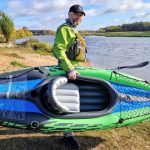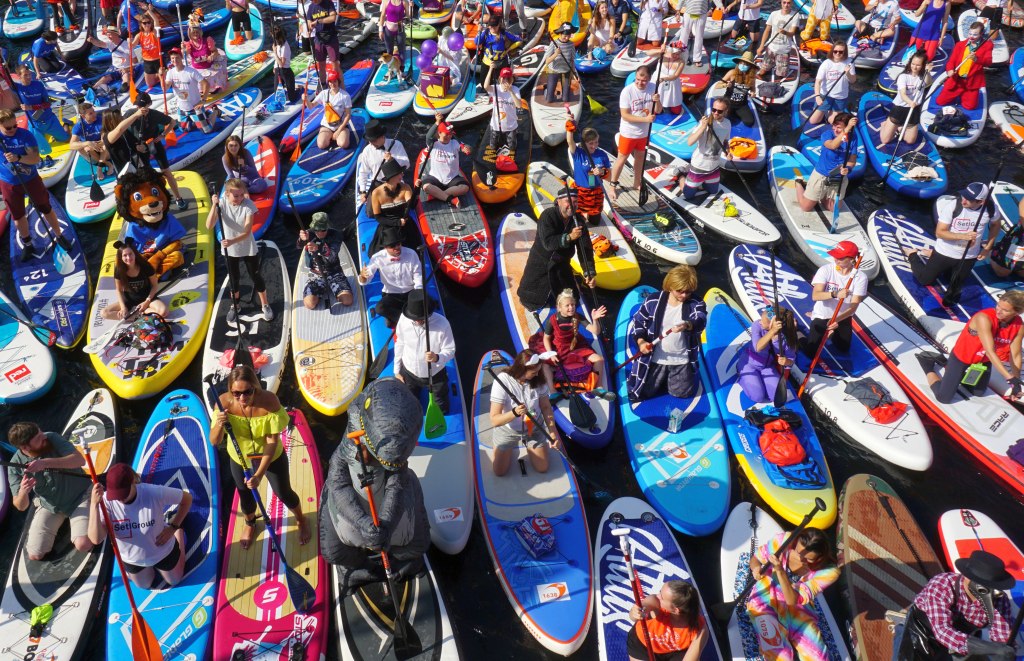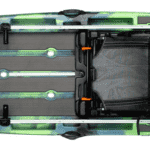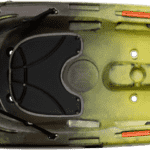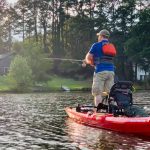Why the right size paddle board matters? From this guide you'll know everything necessary to find the paddle board best sized for you.
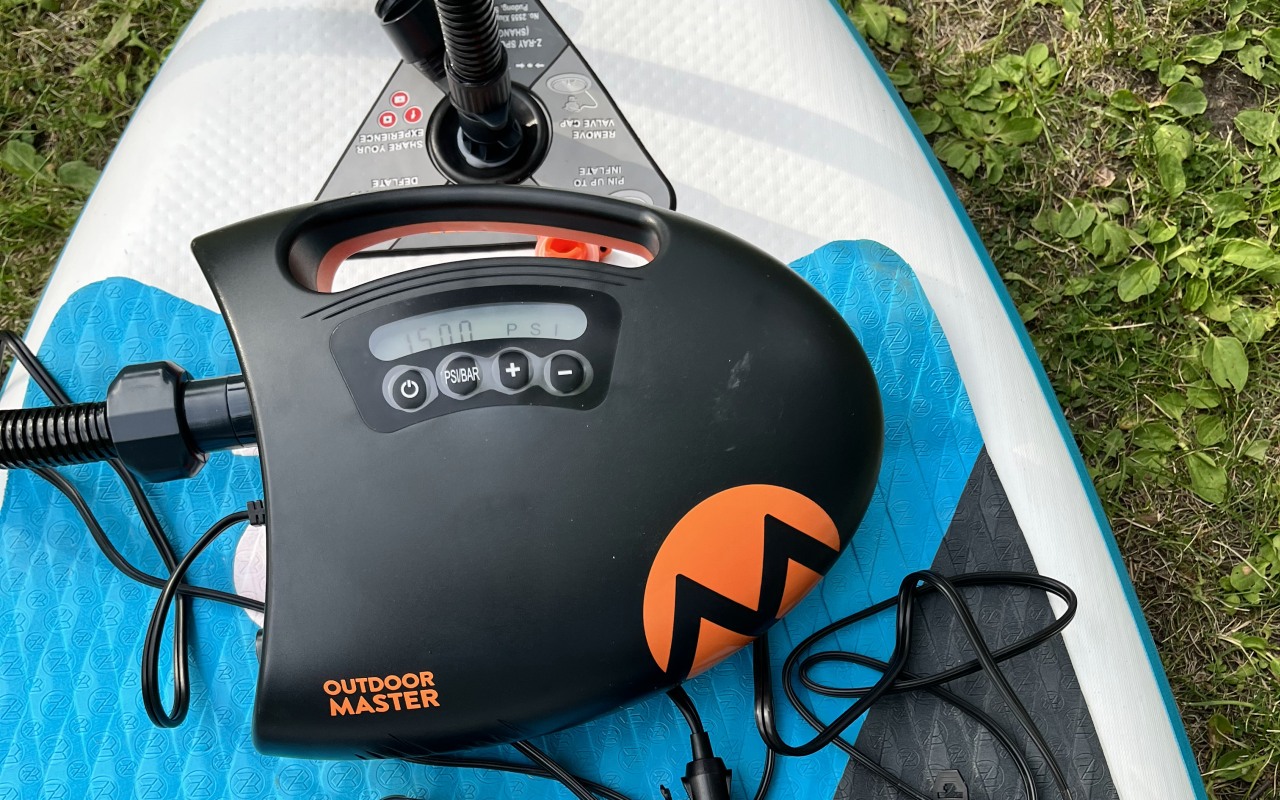
If there’s one downside to owning inflatable paddle boards, it’s all the work that goes into inflating them.
I used to spend 20+ minutes pumping away and sweating buckets to get our family’s three boards inflated so we can get out on the water.
But by the time I was done, I was too tired to enjoy paddling.
That’s why I was so excited to get my hands on the OutdoorMaster Shark II electric SUP pump!
As you’ll see from my detailed review below, it has turned out to be a game-changer to make my lake days more relaxing and hassle-free.
All I’ve got to do now is plug the pump into my car’s 12V power supply, connect the hose to my paddleboard’s valve, and sit back to let the pump do its thing.
Quick, easy, and highly efficient—what more could you ask for?
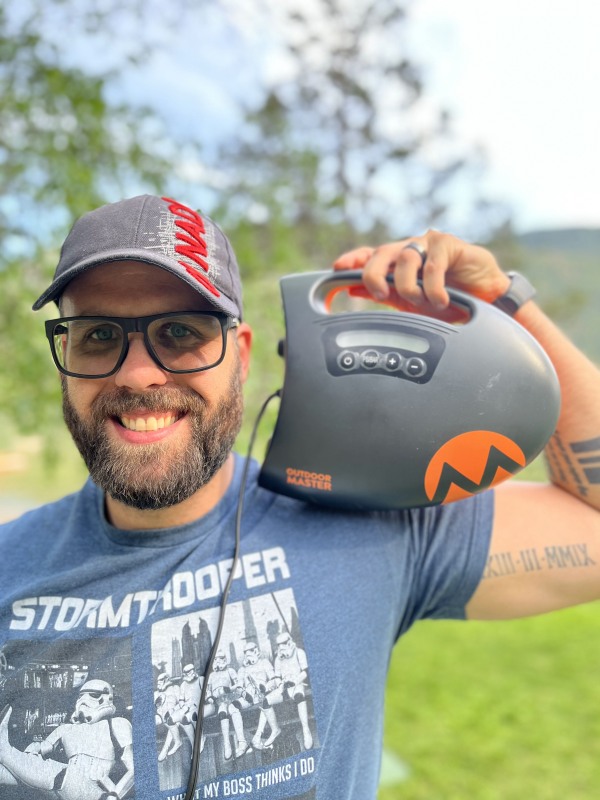
As an affiliate of Amazon and other retailers, we may earn a small commission when you buy via our links, at no additional cost to you. Thank you!
What You Need to Know
| Inflation Speed: | Around 12 minutes to inflate an average-sized SUP |
| Display: | LCD Digital Display |
| Max PSI: | 20 PSI |
| Power Source: | Only 12V DC connector (includes a 12A fuse so it won’t damage your car) |
| Warranty: | 2 years |
| Safety Features: | Auto shutoff, Frost Active Cooling System |
Technical Specifications
| Weight: | 3.6 pounds (1.63 kg) |
| Size: | 12.48 x 10.55 x 7.24 inches (31.7 x 26.8 x 18.4 cm) |
| Nozzles: | HR/H3, C7, Pinch, Boston, and 805 Valve |
| Max Energy Consumption: | 10A, 120W (12V), DC |
| Pumping Speed: | 350L/Min At 1st Stage70L/Min At 2nd Stage |
| Dual Inflators Switch Point: | 1 PSI |
| Power Cord Length: | 9 ft (2.75 m) |
| Hose Length: | 4.5 ft (1.35 m) |
| Supported Pressure Range: | 0.5-20 PSI (0.034-1.378 Bar) |
| Digital Sensor Accuracy: | 0.01 PSI |
What’s in the Package?
Opening the box, it’s pretty easy to see all of its contents at a glance.

Inside, you get the pump with a 9-foot power cable attached, the hose and its multiple connectors, and the instruction manual.

What’s not pictured there is all of the nozzles that come attached to the pump. The OutdoorMaster Shark II’s Amazon page has a much better picture:
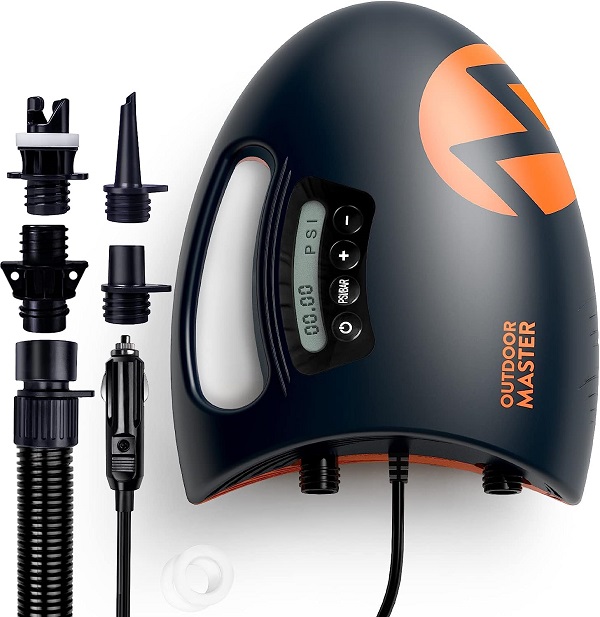
The hose comes with five nozzle attachments:
- Halkey-Roberts/H3 nozzle, which are compatible with the nozzles used by the majority of SUPs
- Pinch nozzle, great for lower-pressure inflatables, floating islands, pool toys, and inflatable mattresses
- C7 nozzle, which is compatible with high-performance inflatables (for example, NRS’ rafts and catarafts)
- Boston nozzle, which connects to the two-way valves used on inflatable boats, pool toys, and mattresses
- 805 nozzle, which offers high-speed inflation and is often used for air beds and inflatable boats
For your SUP use, you’ll find that you really only ever need the HR/H3 nozzle. The OutdoorMaster website includes a long list of all the SUPs that are compatible with this nozzle, including:
- iRocker
- Isle
- Bluefin
- Blackfin
- Thurso
- Advanced Element
- Hydro-Force
- Penguin
- Red Paddle
- Nixy
- ROC
- Bote
- Atoll
- Fanatic
- Body Glove
- Hero Gladiator
- Shark SUP
- Focus Hawaii
- Sea Lion
But the great thing about all the other nozzles included in the box means you can inflate pretty much everything—from air mattresses to floating islands to inflatable boats. Very versatile and practical for camping or travel!
Plugging It In
Like most electric SUP pumps, the OutdoorMaster Shark II is designed to be connected to your 12V car power.
The 9.5-foot cord with 12V connector is actually longer than average (most come with a 6-foot cable), so it is easy to connect the pump to your vehicle’s 12V power supply wherever it’s located.

For example, my Honda Pilot has the 12V port located both directly beneath the steering wheel and in the trunk, whereas my Toyota Corolla has it located in the armrest console between the driver and passenger seats.
Thanks to the extra-long cable, I can easily connect the pump to the 12V power supply on both cars and let it do its thing.
One area where the OutdoorMaster Shark II doesn’t quite match up against some of its competitors is that it’s only compatible with a 12V power supply.
The TOPUMP 7500mAh Rechargeable SUP Air Pump TPS300, for example, has its own built-in battery that lets you operate it without needing to plug it into your car’s power supply. Another of OutdoorMaster’s pumps, the Whale, can be used with a 110V power supply, compatible with any electric generator or battery pack.
However, the “norm” for electric SUP pumps is to only operate on 12V DC power, and only a few of the higher-end models have these extra features.
Carrying It Around
Right out of the box, I loved carrying the OutdoorMaster Shark II around. As you can see, the handle is sized just right to fit my hand:

The curvature of the handle fits neatly in my palm and at 3.6 pounds, it’s light enough that even my wife can haul it around no problem.
I’ve been carrying it around in the box it shipped in, mainly so it’s easier to stack among my camping gear and keep all the components and valves in one place. I would love for it to come with a carry bag included (like the mesh bags that BodyGlove ships their electric SUP pumps in), but OutdoorMaster doesn’t appear to be offering that any time soon.
If I had one complaint about the pump’s portability, it’s that it’s just a little too large to fit into my inflatable SUP’s bags.
The Shark II is a fairly large pump: 12.48 x 10.55 x 7.24 inches ((31.7 x 26.8 x 18.4 cm).

I’m a big dude (6’6” (198.12 cm) tall), and you can see that the pump is about the size of my lower torso. I’ve tried to pack it every which way into my SUP’s backpacks (both of them) and no matter what I do, it’s too thick, wide, or tall to fit.
Compare that to other models—for example, OutdoorMaster’s Dolphin or the BodyGlove Electric iSUP Pump—and they are far more portable than the Shark II.
Inflation Speed
Really, when it comes down to it, the inflation speed is probably the most important factor to consider. Or at least top three (along with reliability and safety).
When I’m shopping around for an electric SUP pump, I want one that’ll inflate my paddle boards as quickly as possible. After all, less time spent waiting for the boards to inflate means more time spent out on the water!
According to OutdoorMaster’s website, the Shark II is supposed to inflate the board “within 5-10 minutes”. Sounds pretty good, right?
I put that to the test!
For the first test, I connected the pump to my car’s power supply and set a timer to start counting the minute it got to work.

Thanks to its 350L/min output at the low-pressure, high-volume Stage 1, it inflated the paddleboard to 1 PSI in about 90 seconds. Off to a great start.
Once it kicked into Stage 2, the output of 70L/min (pretty standard for all the SUP pumps I’ve tested) set in for the long, slow process of bringing the board up to 15 PSI (which I pre-set using the digital LCD screen). Now it was time to sit back and wait.
And wait.
And wait…
For my paddleboard (an 11-footer), it blew past the 5-minute mark, and then the 10-minute mark, with no signs of slowing.
It wasn’t until we hit the 12 ½ minute mark that it finally reached the set 15 PSI:

For the second test, I wanted to try something different, to see if maybe my car’s power was causing it to perform more slowly than the product’s website claimed, or if the extra length of my board just took longer to fill.
I connected it to my 10’10” (330.2 cm) board (a little shorter), and instead of hooking it up to my car power supply, I plugged it into the GoSun 266 Power Bank, a portable battery pack I take camping, hiking, and fishing. The power bank comes with a 12V DC connector, perfect for plugging in the Shark II.
Again, I set my timer and let the pump do its thing.
Turns out that the battery pack produced just fractionally less power than my car supply, because inflating the smaller SUP took even longer:

13 minutes and 49 seconds. Definitely above the 5-10 minutes claimed by the website.
Important Safety Features
What I like about the Shark II is that it comes with two very critical safety features:
12A Fuse – The addition of an integrated fuse protects both the pump from an overload of electric current that could damage it, and a short circuit that could damage the electric components of my car. It’s not a feature that all electric SUP pumps have, but one I’m very glad for.
Frost Active Cooling System – OutdoorMaster’s patented active cooling system expels hot air and sucks in cool air to prevent the pump from overheating. On blistering hot summer days (when the temperature is climbing towards 100+ F), it’s an absolute must-have. It keeps the pump’s mechanisms from getting too hot and burning out (which has happened to me with cheaper-quality pumps).
One great thing about the Frost Active Cooling System is that it’ll also keep the pump from overheating when used for prolonged periods of time—say, for example, when pumping up multiple inflatables or SUPs.
The website claims that it can inflate up to three SUPs without pause. I put that to the test and found on this, the pump lived up to its claim. I was able to inflate a third SUP after my initial two tests and the pump didn’t overheat or shut off.
(It’s worth noting, though, that giving it a few minutes of inactivity to cool down between SUPs does help to keep it working better and reduces risk of overheating.)
How High Can It Go?
The OutdoorMaster Shark II is capable of inflating your SUP, raft, cataraft, or other inflatables up to 20 PSI.
I only use it at 15 PSI (the recommended pressure for my SUPs), but it’s good to know that it can go higher if I ever want to inflate my SUPs a bit more (say, when loading them with extra gear) or if I ever buy a higher-end inflatable boat or kayak.
Save Time With the Auto Shut-Off
The auto shutoff feature is one of my favorite things about the OutdoorMaster Shark II.
The LCD digital screen allows me to set the pump to my target PSI (usually 15), and when the pump reaches that target, it automatically shuts off. No need for me to turn it off manually!
What I love about this is that I can connect the pump to my SUP and let it do its thing while I finish unloading my car, setting up camp, or even grabbing a drink or snack. As long as I keep an ear out for when the pump shuts off, I can go about other tasks while it’s inflating my board.
It’s made lake days and camping trips so much more enjoyable.
How Noisy is It?
I did some pretty intensive internet sleuthing to find out just how noisy it is, and I’ve found results ranging between 70 and 82 decibels (during the noisier Stage 2).
To compare that to other real-life noises (based on research from Purdue University), that’s about as loud as:
- Music in your living room (around 76 db)
- Vacuum cleaner (70 db)
- Garbage disposal or dishwasher (80 db)
When I’m standing right in front of the pump and it’s working away in the high-pressure Stage 2, it’s noisy enough that carrying on a conversation with my wife or kids is a hassle. But all I need to do is move about 10-15 feet away, and it’s no longer an issue.
Inflation + Deflation
One great feature about the Shark II is that it comes with both inflate and deflate connectors:

95% of the use, obviously, is going to be with the inflate port. It does all the hard work of filling up my SUP, while deflating is an absolute breeze and doesn’t usually require electric deflation.
That being said, at the end of every paddling season, I do like to deflate the boards fully so they pack down as small as possible. I’ll also use the deflate setting for packing up air mattresses and floating islands.
Warranty
OutdoorMaster backs up the Shark II with a 2-year warranty, which surpasses most of the warranties offered by their rivals.
Having tested the Shark II along with other electric pumps (including Chinese brands), I can see why the brand would stand by its products with such confidence. I’ve been using it for just one season, but it’s shown no sign of slowing down, losing power, or deteriorating with repeated use.
How Does It Compare to Other OutdoorMaster SUP Pumps?
| Shark II | Dolphin II | Whale | Cachalot | |
|---|---|---|---|---|
| Weight: | 3.6 pounds (1.63 kg) | 2.8 lbs. (1.27 kg) | 7.5 lbs. (3.4 kg) | 4.73 lbs. (2.15 kg) |
| Size: | 12.48 x 10.55 x 7.24 inches (31.7 x 26.8 x 18.4 cm) | 10.31 x 6.89 x 6.46 inches (26.2 x 17.5 x 16.4 cm) | 16.1 x 11.5 x 7 inches (40.9 x 29.2 x 17.78 cm) | 14.25 x 7.17 x 7.09 inches (36.2 x 18.2 x 18 cm) |
| Power Source: | 12V DC | 12V DC | 12V DC, 6000 mAh battery, 110V power supply | 12V DC |
| Pumping Speed: | 350L/Min at 1st Stage70L/Min at 2nd Stage | 40L/min | 350L/Min at 1st Stage70L/Min at 2nd Stage | 350L/Min at 1st Stage70L/Min at 2nd Stage |
| Dual Inflators Switch Point: | 1 PSI (0.07 Bar) | N/A | 1 PSI (0.07 Bar) | 1 PSI (0.07 Bar) |
| Supported Pressure Range: | 0.5-20 PSI (0.034-1.378 Bar) | 0.5-20 PSI (0.034-1.378 Bar) | 0.5-16 PSI (0.034-1.103 Bar) | 0.5-20 PSI (0.034-1.378 Bar) |
| Notable Features: | Pump up to 3 boards without stopping | Compact enough to fit in SUP backpacks | USB port charger + LED light | Ultra-sturdy and stable design |
| Price: | $103.89 | $65.99 | $194.97 | $89.99 |
My Conclusions
After testing it out, I’ve come to the conclusion that the Shark II is a truly reliable, hard-working, long-lasting pump.
Features like its high air flow, five nozzles, real-time pressure monitoring, active cooling, auto shutoff, built-in 12A fuse, and extra-long power cord makes it both convenient and safe to use. The fact that it’s backed by a 2-year warranty leads me to believe I’ll get at least 3+ summers of use out of it.
Sure, it’s got some things I didn’t love—it’s a bit too bulky to be easily portable and it’s slower to inflate than its page claims—but considering the very reasonable price tag, I’m happy to say it’s an electric pump I’ll not only use for as long as it lasts, but recommend to all of my friends and fellow paddle boarders.



